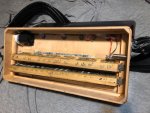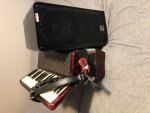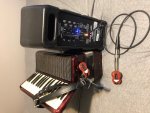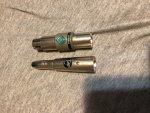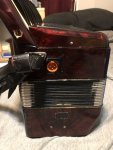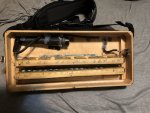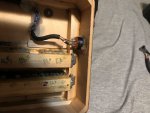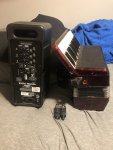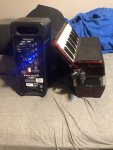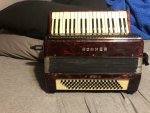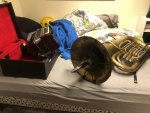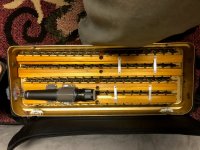To summarize my accordion microphone adventures in getting myself to a satisfactorily functioning state in a very loud rock/folk band I present to you the following;
I began by cannibalizing a working SM58 for the mic capsule and affixed it to the interior of the accordion at a suitable location; using a combination of screws, hot glue and bits of 30 gauge sheet metal fashioned into custom brackets. In terms of positioning I found it best to have it at the bass end of the treble side of the accordion - it really did give the best overall sound quality and has the added bonus of being able to disassemble the accordion without disassembling the microphone setup. I used an appropriate gauge of wire (I don't recall the gauge exactly but...it works!) and wired the capsule to a 1/4" female jack (a sealed jack - a lot of these jacks are not sealed and will allow air to pass through). All of the parts and supplies to do this are under $20 except for the microphone capsule. Total time to do the work is under an hour.
The rest of the system is all gear with no assembly required.
I use an Amoon guitar wireless system that cost about $80 https://www.ammoon.com/p-i4092.html
From here depending upon the situation the signal chain changes, but there are two basic scenarios I am prepared for.
1). If I am playing by myself I plug the receiver portion of the Amoon system into a 1/4" to XLR adapter (@10$) and then the adapter plugs into a TritonAudio FEThead ($115) inline microphone preamp ( https://www.tritonaudio.com/fethead) . This I plug directly into the first channel on an EXM Mobile ($650 new but much less used ) ( http://yorkville.com/loudspeakers/excursion/product/exm-mobile/ ).
) ( http://yorkville.com/loudspeakers/excursion/product/exm-mobile/ ).
2). If I am playing with a band I insert a small mixer (@$100) into the chain before the EXM Mobile so I can better sculpt the sound to adapt to the other instruments, particularly bass. If a bass is present I cut my bass a lot - alternatively if one is not present I will boost the bass quite a bit.
The EXM Mobile is nice because it is lightweight to pack around, is loud enough to function as a stage monitor and has a XLR In/Out Link system which I effectively use as a DI for the soundman. The other thing that the EXM comes with is phantom power on all channels, which is required for the FEThead to function.
Total spent was about $750. Very minimal soldering and hole drilling was required. This is a very simple thing that anyone should be able to do with minimal tools and knowledge. The only issue I have encountered with this method is a lot of hiss due to the gain required for the 58 to pick up adequately all notes in the accordion. I am looking to see if there is such a thing as a more sensitive dynamic mic capsule out there, as well as adding a noise gate or mute switch for those times I am not playing to cut the hiss. But in a very loud band, this actually does not really matter!
The only other issues a person might face with this setup is finding enough room inside the accordion to actually fit the capsule and 1/4" jack.
Pictures for posterity, feel free to add any corrections or suggestions. For example there are only two wires coming from the capsule, when normally there are three - perhaps this should be done differently!? Dislcaimer - I am not a professional - attempt at your own peril and enlightenment!
I began by cannibalizing a working SM58 for the mic capsule and affixed it to the interior of the accordion at a suitable location; using a combination of screws, hot glue and bits of 30 gauge sheet metal fashioned into custom brackets. In terms of positioning I found it best to have it at the bass end of the treble side of the accordion - it really did give the best overall sound quality and has the added bonus of being able to disassemble the accordion without disassembling the microphone setup. I used an appropriate gauge of wire (I don't recall the gauge exactly but...it works!) and wired the capsule to a 1/4" female jack (a sealed jack - a lot of these jacks are not sealed and will allow air to pass through). All of the parts and supplies to do this are under $20 except for the microphone capsule. Total time to do the work is under an hour.
The rest of the system is all gear with no assembly required.
I use an Amoon guitar wireless system that cost about $80 https://www.ammoon.com/p-i4092.html
From here depending upon the situation the signal chain changes, but there are two basic scenarios I am prepared for.
1). If I am playing by myself I plug the receiver portion of the Amoon system into a 1/4" to XLR adapter (@10$) and then the adapter plugs into a TritonAudio FEThead ($115) inline microphone preamp ( https://www.tritonaudio.com/fethead) . This I plug directly into the first channel on an EXM Mobile ($650 new but much less used
2). If I am playing with a band I insert a small mixer (@$100) into the chain before the EXM Mobile so I can better sculpt the sound to adapt to the other instruments, particularly bass. If a bass is present I cut my bass a lot - alternatively if one is not present I will boost the bass quite a bit.
The EXM Mobile is nice because it is lightweight to pack around, is loud enough to function as a stage monitor and has a XLR In/Out Link system which I effectively use as a DI for the soundman. The other thing that the EXM comes with is phantom power on all channels, which is required for the FEThead to function.
Total spent was about $750. Very minimal soldering and hole drilling was required. This is a very simple thing that anyone should be able to do with minimal tools and knowledge. The only issue I have encountered with this method is a lot of hiss due to the gain required for the 58 to pick up adequately all notes in the accordion. I am looking to see if there is such a thing as a more sensitive dynamic mic capsule out there, as well as adding a noise gate or mute switch for those times I am not playing to cut the hiss. But in a very loud band, this actually does not really matter!
The only other issues a person might face with this setup is finding enough room inside the accordion to actually fit the capsule and 1/4" jack.
Pictures for posterity, feel free to add any corrections or suggestions. For example there are only two wires coming from the capsule, when normally there are three - perhaps this should be done differently!? Dislcaimer - I am not a professional - attempt at your own peril and enlightenment!

